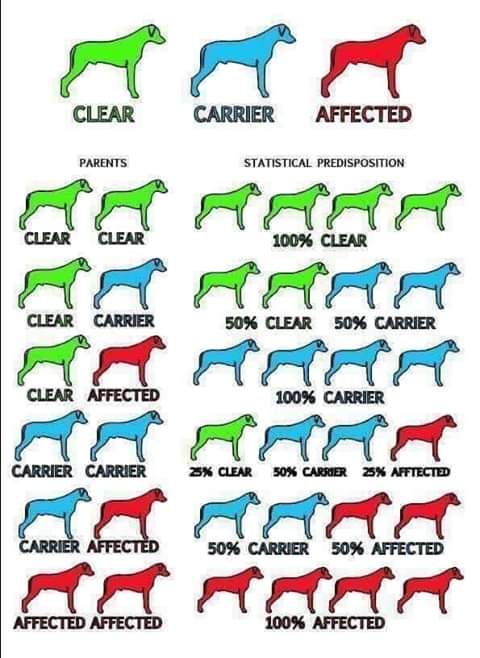Dobermann HealthTesting

Cardiomyophy
Cardiomypathy is fairly common in the dog, With certain breeds showing a distinct disposition to develop the dease. It is Characterised by dilation of the heart and by weakened, thin heart muscles walls ( so that there is less ability to pump blood). Varies breeds are suspected to have genetic tendencies towards the development of this condition, although other factors are also envolved in some breeds. Cardiomypathy results in the heartmuscle becoming dilated and thin, such thatit is unable to act as an efficient pump. In addition- due to the amount of stretching of the heart wall - severe arrhymias ( or irregular, often very rapid heart rhythms) Occur commonly. Some dogs can die suddenly of an arrhythmia; others show weakness, lethargy, syncope ( fainting) and panting at rest. Diagnosis is via echocardiography ( heart Ultrasound) and there are various medications used to help the heart contract more forcefully and control arrhythmia.
Clinical signs of Cardiomyopathy are commonly seen around the ages of three to six years signs of heart failure or arrhythmia are more common in males than females, however females are not less likely to develop cardiomyopathy, the just do not develop clinical signs as often as males. This is sometimes called "occult". Generally most dogs are treated as outpatients, with a low salt diet and medications; However the prognosis is relatively poor. The condition can not be cured, servival times after diagnosis with in weeks to months. Research is being conducted in many breeds, not only looking at the genetics of cardiomyopathy, but also the pathophysiology with the disease in each breed. (orivet) Please refer to webites for more information.
Dobermann breeders carefully select there breeding stock often by doing salavia DNA testing for Cardiomyopathy one and varient two. This reduces risks but is not conclussive there are also cardio ultrasounds and heart monitor testing available.
Von Willebrand"s Disease
Von Willebrand's Disease (vWD) is a blood disease caused by a deficiency of von willebrand factor(vWF), an adhesive glycoprotein in the blood required for normal platelet binding ( clotting) at the sites of normal blood vessel injuries. In addition, vWF is a carrier protein for coagulation Factor V111 ( necessary for blood to clot). A lack of vWF impairs platelet stickiness and clumping. Similar to Hemophila in humans, this condition, this condition can lead to exessive bleeding following an injury, due to the lack of clotting.
vWF is an autosomal ( non sex- linked) trait, which both males and females can express and transmit genectically and with equal frequency. The expression pattern of the severe foms ( Types 2 and 3 vWD ) is recessive while the milder form ( Type 1 vWD) appears to be recessive or completely dominant. This is the most common hereditary blood clotting disorder in dogs, occuring with more frequency in some breeds, including german shepherds, Dobermann Pinschers, standard poodles, shetland sheep dogs and golen retrievers.(2009) Petmed.
We also test our German Pinscher for this as Dobermann is related to the breed.
DNA Testing is available by various companies and reccommended to test prior to breeding.
